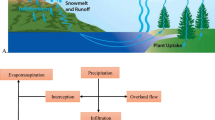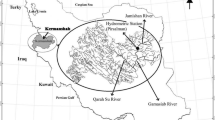Abstract
Time series modelling and control of hydrological parameters are the most critical issues in water resources management. The subject matter of this study is finding the significant relationship between natural properties of time series like correlogram and selecting the best combination set of inputs for the fuzzy-neural adaptive network model. In this regard, two different types of the ACF, including sinusoidal and descending shapes, are considered in different climate. Selecting model inputs from the stability range of the ACF diagram for any shape types and model fine tuning lead to inferior results in testing stage. The best R-value of the original temperature and groundwater time series in stability range is 0.2 (|SI|= 1.23, RMSE = 11.91) and 0.2 (SI = 0.14, RMSE = 3.32), respectively. When they choose from the non-stationary range of the ACF, the powerful results for sinusoidal and descending ACF shapes would be achieved. In case, the R-value is more than 94% (|SI|< 0.57, 2.57 < RMSE < 5.5]) and 78% (SI = 0.03 and RMSE = 0.71), respectively. Whether they are picked up from the absolute maximum of ρ value in the ACF diagram, the best model results would have appeared. By applying the inverse of standardization and reforming the shape of the descending ACF to sinusoidal form, R-value is upgraded about 18%, from 78 to 96% the case. Finally, using preprocessing, in particular, standardization on time series does not always lead to improve forecasting model accuracy, but it depends on the shape of the ACF diagram. If it has the sine periodic shape, applying this action leads to poor results. In opposite, by descending ACF shape, using the inverse of standardization can improve the model accuracy in case. Finally, choosing ANFIS model inputs using the ACF diagram and appropriate input sets are more effective than using the model tuning and different fuzzy generators.











Similar content being viewed by others
Explore related subjects
Discover the latest articles, news and stories from top researchers in related subjects.References
Khashei M, Rezvan MT, Hamadani AZ, Bijari M (2013) A bi-level neural-based fuzzy classification approach for credit scoring problem. Complexity 18(6):46–57
Kousari MR, Zarch MAA, Ahani H, Hakimelahi H (2013) A survey of temporal and spatial reference crop evapotranspiration trends in Iran from 1960 to 2005. Clim Change 120(1):277–298
Chen W, Panahi M, Khosravi K, Pourghasemi HR, Rezaie F, Parvinnezhad D (2019) Spatial prediction of groundwater potentiality using ANFIS ensembled with teaching-learning-based and biogeography-based optimization. J Hydrol 572:435–448
Mirzavand M, Khoshnevisan B, Shamshirband S, Kisi O, Ahmad R, Akib S (2015) Evaluating groundwater level fluctuation by support vector regression and Neuro-Fuzzy methods: a comparative study. Nat Hazards 1(1):1–15
Maiti S, Tiwari RK (2014) A comparative study of artificial neural networks, Bayesian neural networks and adaptive Neuro-Fuzzy inference system in groundwater level prediction. Environ Earth Sci 71:3147–3160
Gong Y, Zhang Y, Lan S, Wang H (2016) A comparative study of artificial neural networks, support vector machines and adaptive neuro fuzzy inference system for forecasting groundwater levels near Lake Okeechobee, Florida. Water Resour Manag 30:375–391
Verma AK, S TN, (2013) Prediction of water quality from simple field parameters. Environ Earth Sci 69:821–829
Daneshmand H, Tavousi T, Khosravi M, Tavakoli S (2015) Modelling minimum temperature using adaptive neuro-fuzzy inference system based on spectral analysis of climate indices: a case study in Iran. J Saudi Soc Agric Sci 14(1):33–40
Azad A, Manoochehri M, Kashi H, Farzin S, Karami H, Nourani V, Shiri J (2019) Comparative evaluation of intelligent algorithms to improve adaptive Neuro-Fuzzy inference system performance in precipitation modelling. J Hydrol 571:214–224
Zare M, Koch M (2018) Groundwater level fluctuations simulation and prediction by ANFIS- and hybrid Wavelet-ANFIS/Fuzzy C-Means (FCM) clustering models: application to the Miandarband plain. J Hydro-Environ Res 18:63–76
Emamgholizadeh S, Moslemi K, Karami G (2014) Prediction of the groundwater level of Bastam Plain (Iran) by artificial neural network (ANN) and adaptive neuro-fuzzy inference system (ANFIS). Water Resour Manag 28(15):5433–5446
Yoon H, Jun SC, Hyun Y, Bae GO, Lee KK (2011) A comparative study of artificial neural networks and support vector machines for predicting groundwater levels in a coastal aquifer. J Hydrol 396(1):128–138
Moeeni H, Bonakdari H, Fatemi SE, Zaji AH (2017) Assessment of stochastic models and a hybrid artificial neural network-genetic algorithm method in forecasting monthly reservoir inflow. INAE Lett 2:13–23
Moeeni H, Bonakdari H, Fatemi SE (2017) Stochastic model stationarization by eliminating the periodic term and its effect on time series prediction. J Hydrol 547:348–364
Affandi AK, Watanabe K (2007) Daily groundwater level fluctuation forecasting using soft computing technique. Nat Sci 5(2):1–10
Bisht D, Shilpa J, Mohan RM (2013) Prediction of water table elevation fluctuation through fuzzy logic & artificial neural networks. Int J Adv Sci Technol 51:107–119
Güldal V, Tongal H (2010) Comparison of recurrent neural network, adaptive neuro-fuzzy inference system and stochastic models in E˘girdir lake level forecasting. Water Resour Manage 24:105–128
Amutha R, Porchelvan P (2011) Seasonal prediction of groundwater levels using ANFIS and Radial basis neural network. Geol Earth Environ Sci 1:98–108
Shirmohammadi B, Moradi H, Moosavi V, TaieSemiromi M, Zeinali A (2013) Forecasting of meteorological drought using Wavelet-ANFIS hybrid model for different time steps (case study: Southeastern part of east Azerbaijan province, Iran). Natural Hazards 96(1).
Nourani V, Kisi Ö, K M, (2011) Two-hybrid Artificial Intelligence approaches for modelling rainfall–runoff process. J Hydrol 402:41–59
Nadiri A, Shokri S, Tsai F, Moghaddam A (2018) Prediction of effluent quality parameters of a wastewater treatment plant using a supervised committee fuzzy logic model. J Clean Prod 180(7):539–549
Wan J, Huang M, Ma Y, Guo W, Wang Y, Zhang H, Li WSX (2011) Prediction of effluent quality of a paper mill wastewater treatment using an adaptive network-based fuzzy inference system. Appl Soft Comput 11(3):3238–3246
Najah A, El-Shafie A, Karim O, El-Shafie A (2014) Performance of ANFIS versus MLP-NN dissolved oxygen prediction models in water quality monitoring. Environ Sci Poll Res 21(3):1658–1670
Darbandi S, Arvanaghi H (2009) Air temperature estimation using artificial intelligent methods (Case study: Maragheh City). Eur J Sci Res 61(2):290–298
Wayan S, Azizan Abu S (2020) Rainfall prediction by using ANFIS time series technique in South Tangerang, Indonesia. Geodesy Geodyn 11(6):411–417
Gonzalez Del Cerro RT, Subathra MSP, Manoj Kumar N, Verrastro S, Thomas George S (2020) Modelling the daily reference evapotranspiration in semi-arid region of South India: A case study comparing ANFIS and empirical models. Inf Proc Agric 8(1):173–184
Aparecido LE, Moraes J, Meneses K, Torsoni GB, Fausto de Lima R, Costa C (2020) Köppen-Geiger and Camargo climate Classifications for the Mid-West of Brasil. Theoret Appl Climatol 142(4):1133–1145
Salas JD, Delleur JW, Yevjevich V, Lane WL (1980) Applied modeling of hydrologic time series. Water resource Publications, Colorado
Moeeni H, Bonakdari H, Ebtehaj I (2017) Integrated SARIMA with s. Water Resour Manage 31:2141–2156
Author information
Authors and Affiliations
Corresponding author
Ethics declarations
Conflict of interest
The authors have no conflicts of interest to declare that are relevant to the content of this article.
Additional information
Publisher's Note
Springer Nature remains neutral with regard to jurisdictional claims in published maps and institutional affiliations.
Rights and permissions
About this article
Cite this article
Fatemi, S.E., Parvini, H. The impact assessments of the ACF shape on time series forecasting by the ANFIS model. Neural Comput & Applic 34, 12723–12736 (2022). https://doi.org/10.1007/s00521-022-07140-5
Received:
Accepted:
Published:
Issue Date:
DOI: https://doi.org/10.1007/s00521-022-07140-5




